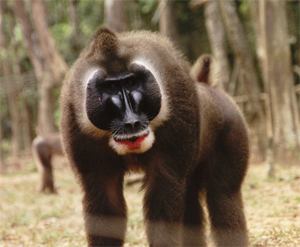The Genus Mandrillus
 The drill is part of a unique genus, Mandrillus, which includes only one other primate, the most colorful mammal known to man - the mandrill.
The drill is part of a unique genus, Mandrillus, which includes only one other primate, the most colorful mammal known to man - the mandrill.
If mandrills are the most colorful mammal, then drills are the second-most colorful! Both drills and mandrills have the same brilliantly hued backside - a feature which is unique in the primate world. The genetalia of Mandrillus species is also brightly colored, especially in the dominant male. As for the differences between these two species, the well-known mandrill's face is red and blue, whereas the drill's is jet black and shiny, without the longitudinal grooves mandrills have in the skin covering the bony ridges on either side of the nose (see the picture gallery below). The dominant male drill has a bright red patch on his chin and pronounced cheek flanges, which are absent in the mandrill and the mandrill sports a yellow beard and ruff while the drill's is short and white. Female and juvenile mandrills are less colorful than the male. The color of the pelage of these two species also differs - in the drill's latin name, the word 'leucophaeus' means 'dusky' and probably refers to the darker brownish hair of the drill, while a mandrill's body hair is usually described as 'olive'.























